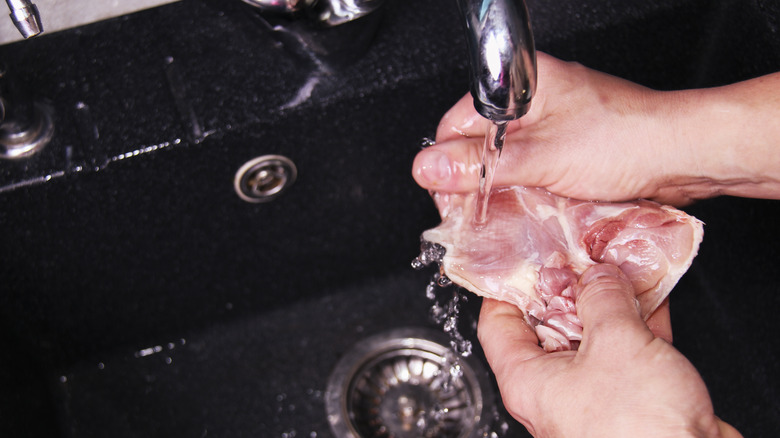The Reason Washing Chicken Before Cooking It Is A Bad Idea
Do you give your chicken a quick rinse under the sink before cooking? If so, stop: You could be spreading salmonella.
FoodSaftey.gov shares the alarming statistic that the U.S. sees around 48 million cases of food poisoning annually. The CDC lists salmonella as the top reason for hospitalizations related to foodborne illnesses. When it lurks in one out of every 25 packages of poultry at the grocery store, it's hard to avoid.
In 2013, NPR reported that as many as 90% of Americans rinsed their birds prior to cooking, citing research from the U.S. Department of Agriculture. That year, a virulent outbreak of an antibiotic-resistant salmonella linked to Foster Farms, a poultry farm in California, sparked a newfound interest in poultry prep, according to Live Science. It even prompted Drexel University to release a public service campaign advising Americans not to wash chicken. Over 40% of people stricken with Foster Farms' salmonella were hospitalized, per the Los Angeles Times.
Eatocracy, meanwhile, explains that we can blame Julia Child for our penchant for poultry baths. The beloved cookbook author-turned-PBS-sensation-turned-national icon recommended in her seminal "Mastering the Art of French Cooking: Volume 1" that poultry be rinsed before cooking. Lest Child take all the heat, James Beard, Fannie Farmer, and even "The Joy of Cooking"'s Irma Rombauer all have recommended hosing down a raw bird before cooking.
Can't stomach eschewing Julia Child's advice? Even Julia-devotee Ina Garten refuses to rinse her birds, as reported by "Today."
Why you shouldn't rinse raw chicken
Plopping raw chicken under a spray of water won't rinse salmonella away. Instead, it not only contaminates the sink, but it can spread the pathogens as much as three feet in any direction, according to EatingWell.
Per the outlet, rather than turn your kitchen into a breeding ground for food borne illness, it's best to keep chicken away from the sink. Instead, pat the meat dry with paper towels to remove the purge — the liquid found in the packaging — before cooking.
The best way to kill salmonella and other bacteria is with proper cooking. The Food Network says the USDA recommends cooking poultry to an internal temperature of 165 degrees, ensuring you've killed the pathogens and rendered your dinner safe. A good meat thermometer is a worthwhile investment.
Watch out for cross contamination, as well. BBC Good Food advises washing anything that's come into contact with raw chicken, like knives or basting brushes, and sanitizing all work surfaces. Chicken should have its own cutting board, says Taste of Home, made of a non-porous material. Wood absorbs bacteria, where it burrows into the grain and flourishes.
Finally, Food Safety News reminds us to be extra fastidious about hand washing when working with raw meats.

